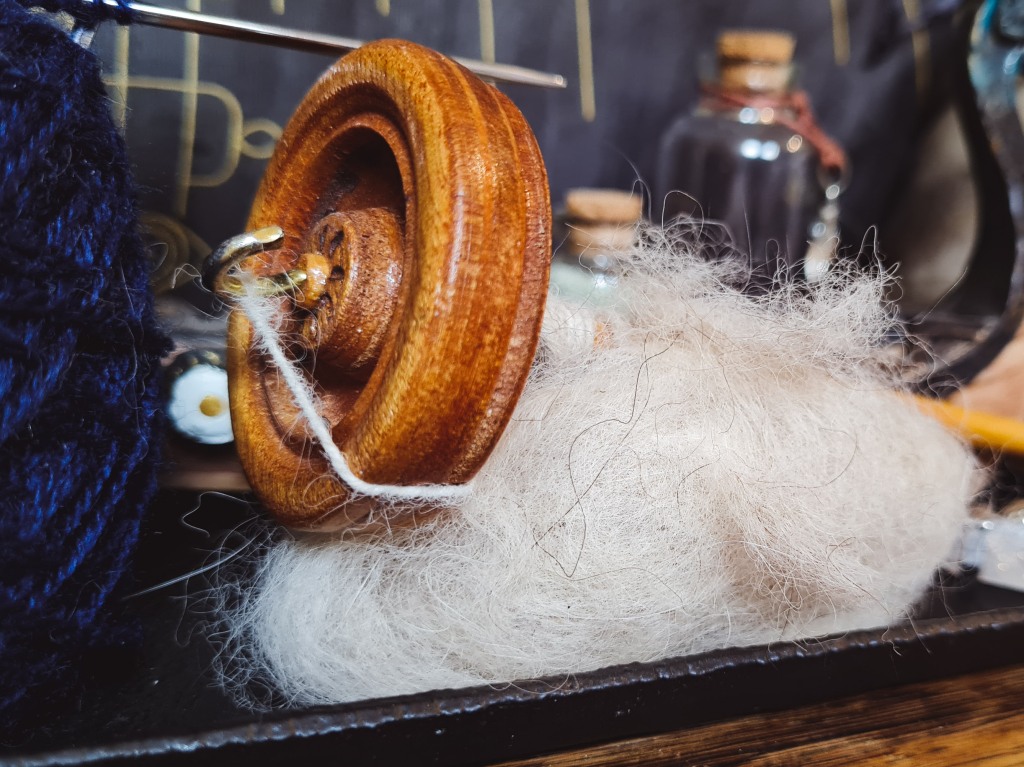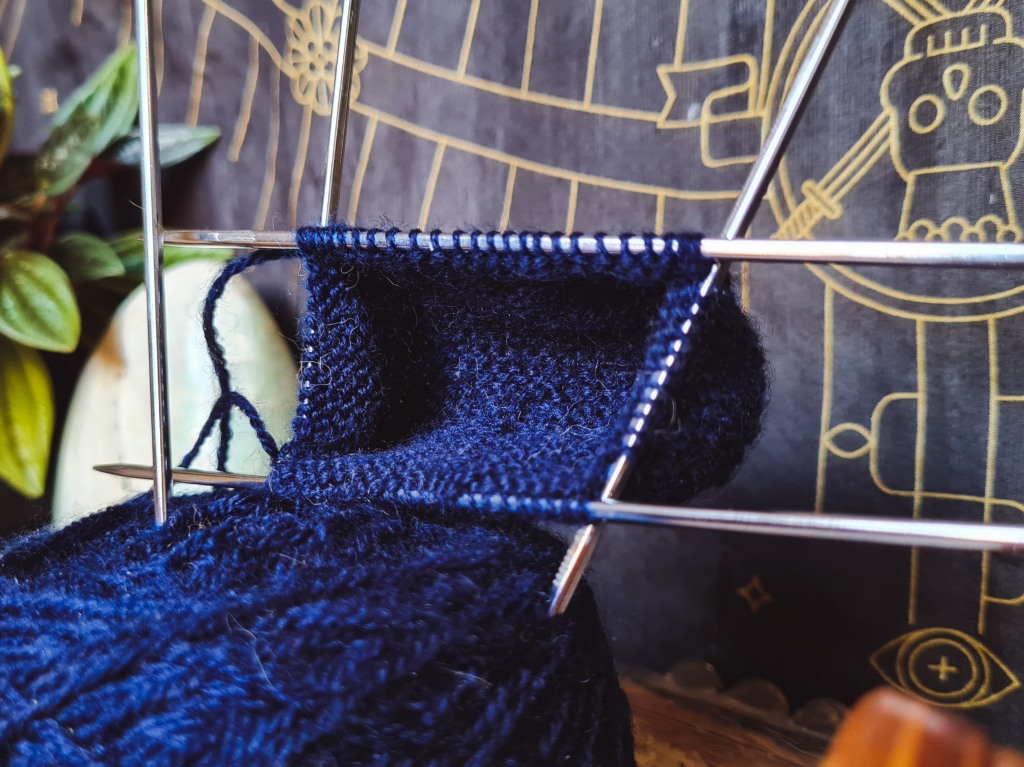Mundane magic remains one of my favourite things, the subtle incorporation of a magical mindset and behaviour in seemingly mundane thoughts and acts. I’ve written about it before a few times in 2021 and 2018, on journaling and tea/coffee. This year I hope to write to you about mundane magic some more, when incorporated into hobbies for example, like fiber crafts that I shall discuss in this blog.
Fiber Craft
Why am I so interested in fiber craft? This year (2022) I started getting into knitting, and its been very satisfying to work on for me. This is not my first interaction with fiber craft, I’ve spun, needlebound and crochet in the past, I’ve tried a little bit of embroidery and am interested in sewing. My mother also spins with a spindle and has done band weaving in the past. It’s a method for me to make things myself that will be of use and personal, while being quite accessible.
So let’s be clear what I mean with “fiber craft”. Every act that utilizes fiber, be it in the form of un-spun wool, yarn or fabric, can be considered fiber craft. This therefore includes activities such as spinning, knitting/crochet/needle-binding etc, weaving, sewing and embroidery, just to give a handful of examples. Now, those are a lot of different activities, and definitely aren’t all as comparable to another, but they share a common thing, fiber. These are also quite common hobbies for people to have and been around for quite some time, though at certain points perhaps a little more out of necessity than they are now, but still practical.
There are a lot of aspects to fiber craft you can turn to to incorporate magic into, but I’ll focus on 4 of them here: Material, colour, method and purpose.
Material

Material is such a big component of fiber craft. Be it the fiber you work with or the tools. It can be wool, cotton, silk, or more synthetic fibers, which each will have their own correspondences an attributes to enhance the thing you’re creating with it. Softer materials will likely be more closely associated with love, comfort and safety, while harsher or denser materials may be associated with protection and stability, just to name a few.
Your tools can be wood, where the type of wood can add correspondence to the act, or various types of metals, which also have their own qualities of correspondence. These correspondences will also be things like a quality of “life” in wood, and more that of “channeling” in metals for example, not just “beech is associated with knowledge” or “Brass is associated with the Sun and abundance”.
Being purposeful in your materials lays a solid foundation for the end result, but we can continue the material component into the next aspect, colour.
Now the methods of association and correspondence you use for this and the following will depend on your believes, culture and type of practice, so I intentionally leave it relatively vague so you can see how that works with your own path.
Colour

I think we are all familiar with the fact that colour has an influence on our psychology, as also shown in various research. While it also is an aspect heavily influenced by ones culture, you can use colour associations in your intentional workings as a foundation for those aspects.
A way we can tie material into the colour aspect lies in the dyeing process, which I’ll take apart into two: the dye itself and dyeing process.
The dye used to give your fiber its colour can be made up of synthetic components or natural components. Nothing wrong with synthetic dyes here, but we will ignore it a little bit on this end. When you use natural dye’s they’re most often made of plant or mineral compounds. These materials therefore carry their own correspondences outside of their (resulting) colour and can therefore be picked out based on their original associations to enhance intention.
The dyeing process can be executed with pretty much any type of dye, but when you dye your material yourself you can focus and work the magical intention into the material while you go through the dyeing process itself. It’s not something everyone will make use of, be it for financial, practical or time related reasons, but if it is something you’re interested in, can be a worthwhile part of the process to incorporate.
Method

There are many methods of utilizing fiber in craft and each has its pro’s and con’s. That said, the method can matter, be it in terms of precision, function etc. If you simply want to enchant an item with a decoration, a woven band or bit of embroidery might suffice. If you want to make sealed pouches for spells you may want to use a form such as knitting or sewing, or maybe even weave the fabric yourself.
Method can also matter in other ways, does it consist of a lot of knots like in tatting and needle-binding ? Or loops inside loops as with knitting and crochet? I think you can already picture your own associations in difference between knots and loops as an example.
Does working the specific method allow you to zone out while doing it? Perhaps you can use it as a form of trance or meditation. Spinning and weaving are in fact act’s historically associated with trance related workings such as Seiðr in Heathenry for example.
I’m not saying learn every form of fiber craft, I’d even go as far as to just leave the ones you’re not in the slightest interested in alone. Enjoyment enhances not only your endurance on time consuming projects but also the amount of focus and purpose you can put into the end result.
Another point of interest you may want to look into is if there are any superstitions regarding your method of choice. I know for various methods of craft there are superstitions, like the necessity of mistakes so your soul doesn’t get trapped, and the like. While some superstitions may be funny, some can also tell you a little bit about the folk practices surrounding that activity.
Purpose

Lastly, and perhaps actually the most important part of things we do, the purpose of the act. Now you can work all the intention into a project and use the act as a medium to bring the magic out into the world, but most of the time there’s a intended purpose to the things we make. Be it to be turned into practical or decorative items such as altar cloths, garments or what not.
Is the purpose of your creation to be practical? If it’s to be a container of sorts you may want to consider that when picking correspondences, do you want to enhance the container itself or the thing it is meant to hold? If it is a garment, what’s the occasion for it to be worn at? If it is meant as decor, what do you this decoration to inspire?
Now we can apply these 4 aspects to most things when incorporating the mundane in magic, but I hope my going over them specifically with fiber craft in mind may have given you a little bit of inspiration.
My fiber craft projects
As a bonus let me briefly tell you about my current fiber craft projects.
I intended to write a very different post at first about fiber craft but I thought this format would be more beneficial. I only started knitting in March 2022 but have been picking it up very quickly and easily so if you are interested I’d suggest see if you can get a small kit for socks or something similar. If you enjoy it you can branch out to more expensive tools and materials (I may have jumped a bit early on the tools myself, knowing how I tend to be with handwork crafts and now own 2 sets of KnitPro Nova Cubic needles, which you can see in the pictures prior).
While primarily knitted items, my first attempts at magical fiber craft were sewn, embroidered and knitted tarot pouches. Practical, because these either had bad or big boxes unsuitable for traveling with them or easy storage, while also facilitating an opportunity to personalize, bond with the decks in question.
Currently, while also working on another tarot pouch, I’m working on a scarf, some socks and have just finished up 2 colour work charts for deity focused altar mats. While the clothing pieces are a little less heavy on the magical aspect, I do find them magical in their focus and repetition, aiding me in meditative contemplation for my craft. I hope to at some point explore aspects of Seiðr through knitting when I’m a little more familiar with the process that it takes up less active focus and allows me to zone out a bit more.
I’m also considering asking my mother if I can try out her weaving tools to add to my knitting projects but let’s take it one step at a time for now. Once I’ve finished the items for religious/spiritual/magical use I’ll be sure to talk about them on the blog to hopefully inspire you for your own practice!
